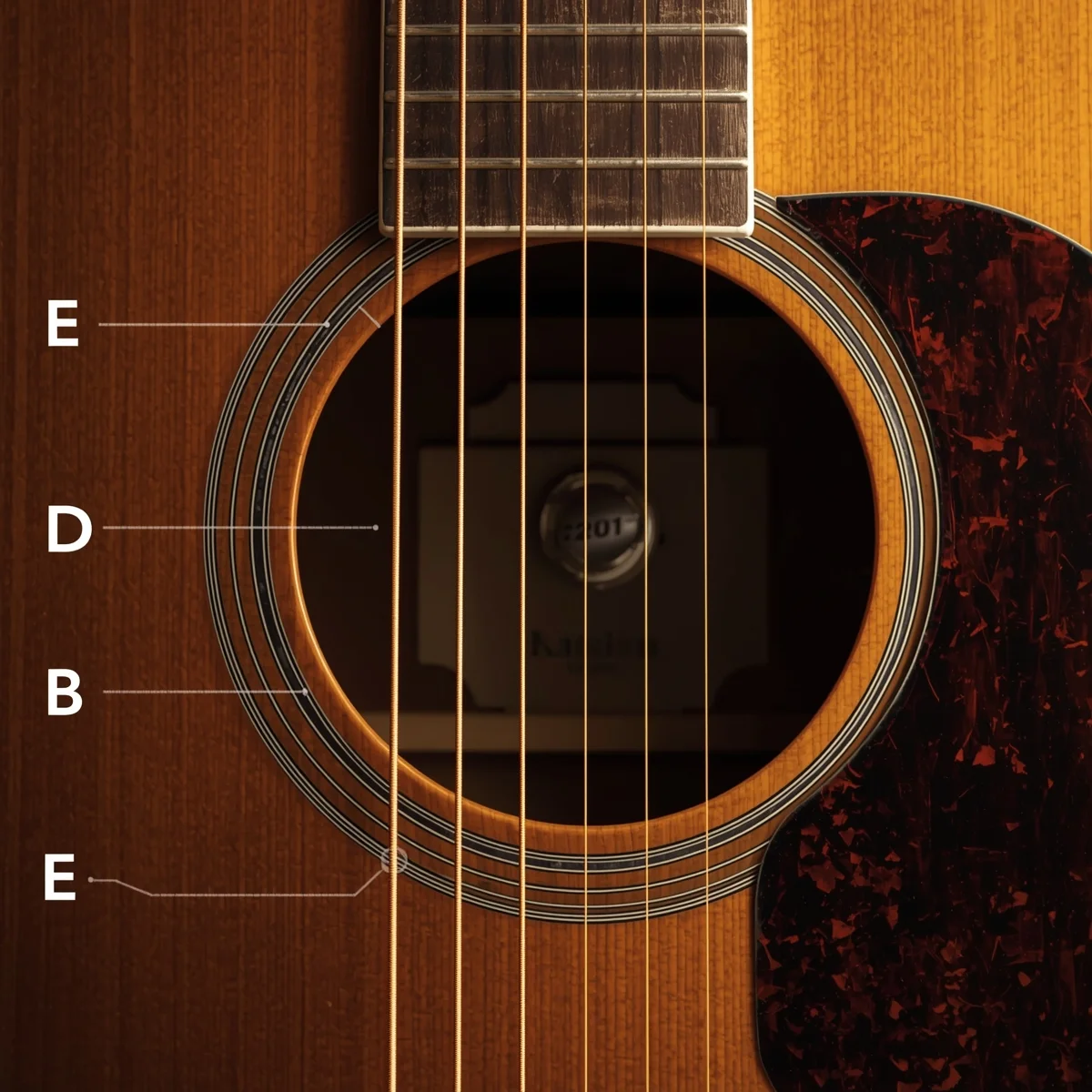The first concept you need to learn before you can play the guitar is understanding the guitar string notes. Even if you are refining your knowledge. The notes provide the basis for the chords, scales, and melodies that you play. If you do not understand them, your progress with the guitar will be slow and frustrating. This article will cover guitar string notes, why they are important, the connections closest to music theory, and tips for memorization. By the end of the article, you will have a clear roadmap to apply all of this to your guitar playing.
What Are Guitar String Notes?
Defined by the music pitches assigned to each string of a guitar, the guitar string notes is an essential concept that every guitarist must understand. In standard tuning, a six-string guitar has six open notes. These notes are the basis of chords and scales that can be played. These notes allow for the rich sounds and versatility of the instrument that you love.
When you play an open string, you play the note to which the string is tuned, without pressing any frets, and these notes change as you press the frets to play higher notes in a predictable sequence.
Most guitars use what is called standard tuning. This tuning has been widely adopted because it balances the shapes of the chords, the patterns of the scales, and the playability of the instrument.
The notes of the guitar strings in standard tuning, from the thickest (lowest pitch) to the thinnest string (highest pitch) are as follows:
E (lowest, thickest) 6th string
A (5th string)
D (4th string)
G (3rd string)
B (2nd string)
E (highest, thinnest) 1st string
This arrangement is often remembered using acronyms or rhymes. Memorization can be tricky, but using simple phrases makes it easier.
Here are a few popular ones:
Eddie Ate Dynamite, Good Bye Eddie
Every Amateur Does Get Better Eventually
Elephants And Donkeys Grow Big Ears
Each word’s first letter corresponds to a string from the 6th to the 1st. Choose the one that sticks best in your memory.
Why Guitar String Notes Matter
Learning the notes on a guitar string requires more than simple memorization. Here are some of the more important aspects:
Building Chords
Chords are built by pressing multiple notes on different strings simultaneously. Knowing the open string notes lets you visualize the chord shapes that you are playing.
Playing Scales
Scales are a sequence of notes that form the building blocks of melodies and solos. If you do not know the notes on each string, trying to play scales will leave you confused.
Tuning Accuracy
You need to know the target pitch of each string to tune the guitar. Knowing the names E, A, D, G, B, E means your guitar is in proper tuning.
Reading Sheet Music or Tabs
String notes are the building blocks of musical notation and tablature. Knowing them will help you play with accuracy and confidence.
Expanding Beyond Open Strings
While you need to know open strings, the fretboard is what expands these notes. Each fret raises the pitch by a half step.
For example:
Open 6th string: E
1st fret: F
2nd fret: F#
3rd fret: G
The same pattern is used across all of the strings. Knowing the notes along the fretboard will give you a greater level of comprehension.
Learning Guitar String Notes on the Fretboard
Learn Natural Notes First
Before learning sharps and flats, concentrate on the seven natural notes: A, B, C, D, E, F, and G. This will streamline the learning process.
Use Landmarks
Remember the notes located at important frets:
5th fret of the 6th string = A
7th fret of the 5th string = E
12th fret = same as open string, one octave higher
These anchors aid in quick navigation.
Practice with Scales
Scales are an effective way to learn the location of notes. For instance, the C major scale will assist you in locating notes on several strings.
Repetition
Identifying notes in the fretboard and strings effectively will develop through consistent and daily practice.
Alternate Tunings and Their Effect on String Notes
Even though standard tuning is most common, many players will experiment with alternate tunings. Common examples include:
- Drop D Tuning (D A D G B E): The 6th string is lowered from E to D, popular in rock and metal.
- Open G Tuning (D G D G B D): Used in blues and slide guitar.
- DADGAD Tuning (D A D G A D): Common in Celtic and folk music.
Every tuning adjusts the open string notes which assumes a different method of playing the associated chords and scales. Familiarity with standard tuning provides a solid foundation to engage with these other tunings.
Guitar String Notes and the Basics of Music Theory
Understanding string notes gives a foundational understanding of music theory. Here’s how:
Intervals
Intervals refer to the distance between two notes. For instance, moving from the open 6th string (E) to the 5th string (A) comprises a perfect fourth interval.
Keys and Scales
Every musical key contains a specific combination of notes that construct the scales. Identifying these notes on your guitar strings enables you to play any key.
Chord Construction
Knowing the root, third, and fifth of a major and minor chord, you can figure out and comprehend chords as these components construct the chord.
Common Beginner Mistakes with Guitar String Notes
Forgetting the String Order
Mistakes happen, and ordering strings incorrectly is common. Practice from the 6th string down and the 1st string up.
Relying Only on Acronyms
Acronyms can be useful, but you need to go beyond them. Aim for notes recognition without acronyms.
Ignoring the Fretboard
Many beginners only memorize the open strings. Learning the fretboard is equally important as mastering open strings.
Inconsistent Practice
Not practicing leaves gaps in knowledge and makes retention difficult. However, regular short practice sessions will always yield better retention than long, spaced intervals.
Practical Exercises For Mastery
- String Naming Drill. Say the note names out loud as you pluck each open string.
- Fretboard Walk. Start on an open string and name every note up to the 12th fret.
- Chord Breakdown. Pick a chord and determine the notes in the chord.
- Scale Mapping. Play a major scale and name each note as you ascend.
These exercises will help you reinforce your knowledge as you practice the more theoretical side of playing.
How Long Does It Take To Learn Guitar String Notes?
With consistent practice, most beginners will memorize the open string notes in a week or two. Mastery of the fretboard takes longer, usually several months, but it is worth the time and effort. Learning to play the guitar is a journey, so patience and persistence will go a long way.
Conclusion
For the guitarist, learning the string notes of the guitar is the most fundamental and essential starting point. It forms the basis of the chords, scales and melodies that the guitarist works with. It is essential in the tuning of the guitar, as well as the reading and musical theory and costing of the guitar.
Hence, begin with the six open strings in standard tuning and use your learning acronyms to memorize before advancing to the fretboard. Over time, something that seems puzzling at first becomes something that comes easily.
Learning the notes on the strings of your guitar will help in the understanding of new chords and scales as well as alternate tunings. In other words, this small piece of knowledge will open up countless opportunities with the guitar.





